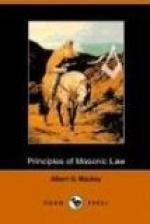The topic to be discussed in this section is, the answer to the question, How shall a Grand Lodge be established in any state or country where such a body has not previously existed, but where there are subordinate lodges working under Warrants derived from Grand Lodges in other states? In answering this question, it seems proper that I should advert to the course pursued by the original Grand Lodge of England, at its establishment in 1717, as from that body nearly all the Grand Lodges of the York rite now in existence derive their authority, either directly or indirectly, and the mode of its organization has, therefore, universally been admitted to have been regular and legitimate.
In the first place, it is essentially requisite that the active existence of subordinate lodges in a state should precede the formation of a Grand Lodge; for the former are the only legitimate sources of the latter. A mass meeting of Masons cannot assemble and organize a Grand Lodge. A certain number of lodges, holding legal warrants from a Grand Lodge or from different Grand Lodges, must meet by their representatives and proceed to the formation of a Grand Lodge. When that process has been accomplished, the subordinate lodges return the warrants, under which they had theretofore worked, to the Grand Lodges from which they had originally received them, and take new ones from the body which they have formed.
That a mass meeting of the fraternity of any state is incompetent to organize a Grand Lodge has been definitively settled—not only by general usage, but by the express action of the Grand Lodges of the United States which refused to recognize, in 1842, the Grand Lodge of Michigan which had been thus irregularly established in the preceding year. That unrecognized body was then dissolved by the Brethren of Michigan, who proceeded to establish four subordinate lodges under Warrants granted by the Grand Lodge of New York. These four lodges subsequently met in convention and organized the present Grand Lodge of Michigan in a regular manner.
It seems, however, to have been settled in the case of Vermont, that where a Grand Lodge has been dormant for many years, and all of its subordinates extinct, yet if any of the Grand Officers, last elected, survive and are present, they may revive the Grand Lodge and proceed constitutionally to the exercise of its prerogatives.
The next inquiry is, as to the number of lodges required to organize a new Grand Lodge. Dalcho says that five lodges are necessary; and in this opinion he is supported by the Ahiman Rezon of Pennsylvania, published in 1783 by William Smith, D.D., at that time the Grand Secretary of that jurisdiction, and also by some other authorities. But no such regulation is to be found in the Book of Constitutions, which is now admitted to contain the fundamental law of the institution. Indeed, its adoption would have been a condemnation of the legality of the Mother Grand




